#this is. always present but a more honed skill in her main verse than the modern (/etc.)
Text
scale of 1 to 10 how unsettled would your character be if Tech recognized them by footstep and/or another movement sound of theirs?
#this is. always present but a more honed skill in her main verse than the modern (/etc.)#because of all the time she spent where so much of her world was defined by Noises#because no one really spoke *to* her (though sometimes *at* her) and all the cues she had to make sense of things was like#when lights and power systems turned on and off. when doors down the hall opened. when footsteps came or went.#how many. how structured. what type of shoes they were wearing- these were important to know#so she got really good at it. mostly by habit mostly just because. it was that or be Lost all the time#and then she just never really shook it. even though it's harder in the desert where the ground is so often soft#and it's not as Necessary per se but it's. still useful to her and she is always listening#...i don't. know whether to hc tag this or not s;dlkfjg;dlfkjg#anyway. daughter thoughts. i love her.
1 note
·
View note
Note
I want your HCs about the generals!
YES so this is gonna be long.
Ezor
- Comes from a large, but very poor family
- Her father was galra, and he loved his wife and kids very much and was a good dad and husband. Alas, he was a low-ranking soldier in the empire and died in battle, leaving his wife and ten kids behind.
- Ezor herself is a middle child, but often acted as the older one because her eldest siblings were not supportive and left the home when they came of age and never came back. Ezor is very bitter towards them.
- Often had to take odd jobs to support her family, mainly in retail and entertainment (where she honed her skills as a gymnast). These jobs (and pressure from being a good older sister) forced her to put on a “mask” of positivism and hide her actual feelings.
- After a number of years in this system she met Lotor who offered her a job as one of his generals after seeing her preform. She initially declined as she didn’t want to abandon her family like her older siblings while also harboring resentment towards the empire for her father’s death.
- Lotor eventually proved himself to be honest and she joined the generals after talking it over with her mother and younger siblings.
- Ezor makes a habit to this day of sending money home and face-timing her family when she has the time.
- Her non-galra species can reproduce sexually and asexually, so one of Ezor’s younger sisters is actually am asexual clone of their mother. Because the sister a product of asexual reproduction, she grew up faster than Ezor and looks older than her.
- Said sister has clone daughters of her own and Ezor loves her nieces very much and sends them presents everytime Lotor’s squad stops at a new place.
- Ezor herself cannot reproduce asexually because of her galra genes, (but she doesn’t mind at all, she’s not ready for kids).
- When Ezor first joined Lotor’s squad she didn’t tell the other generals that she could turn invisible (Lotor knew because he saw her performance) and often played tricks on them (like moving their stuff, stealing little things like their toothbrush). Zethrid never figured it out until Lotor made a plan that required Ezor to spy and use her invisibility powers. You can image Zethrid’s rage.
Narti
- Her blindness is congenital. In fact, her non-galra species naturally don’t have eyes and communicate through telepathy.
- The other generals and Lotor don’t know much about her past, or even her age for that matter.
- She was an experiment at one point, and was infused with quintessence that turned her telepathy from simple communication to mind-control abilities.
- She met Lotor when he went to “visit” the lab in question. He originally wanted to steal some of the information they’ve gathered there. He learned of her powers and asked if she wanted to join to which she agreed.
- Her tail is strong enough to pick up Zethrid, and can pick up Acxa and Ezor simultaneously. She has picked up her friends on occasion (this bothers Acxa more than anyone as it disrupts her while she works).
- Not surprisingly, is the only one who Kova would not bite if she tries to give him a bath.
- Loves audio books and always gets a new one when the group goes to a city with a bookstore. Her favorite genre is classical fantasy.
- Is unnaturally good at space bowling and Zethrid considers her her personal rival.
Zethrid
- is the daugther of a wealthy commander, but illegitimate. And as such was hidden away when growing up.
- Her mother died when she was young, and thus Zethrid has little connect to her non-galra species.
- She was raised by her father learning to fight, and he expected her to become a soldier of the empire. He also didn’t wanted to be publically associated with her. She became a gladiator fighter instead.
- Not only did Zethrid ignore her fathers’ desires she actively declared her parentage live in front of all the spectators.
- Despite being a gladiator, she refused to fight anyone who would obviously lose to her (someone like Matt, for example). It was out of mercy, but she would publically word it as it were an insult to her might.
- Received a lot of hate from racist people on account of her mixed heritage, and the aforementioned refusals.
- Was the first general Lotor recruited before he was exiled, when he was forced to go see a match of her’s with Zarkon.
- She loves playing with Kova, and is one of the only people besides Narti who could brush him without protest from Kova himself.
- Is actually well-eductaed, and knows a lot about weapon creation and mechanics. She is well versed in history and math as well.
- besides gladiator fights Zethrid is champ at space bowling and has gone pro in the past. Almost always gets perfect games and get really upset if she gets a spare.
Acxa
- Is the quintessential nerd, knows a lot of things over a variety of topics. Her main love, however, is chemistry. Once was a in a bad mood for a week because they named a newly-discovered element after the creator and not after the fact that it resembled peanut butter (No one except Narti figured out why she was so upset).
- She knows the space periodic table (over 400 elements) by heart and can recite it normally, by individual rows and columns, by order of electronegativity and metallic character. She is currently working on memorizing all the atomic masses.
- Doesn’t really know what her non-galra species is, but after meeting Keith and Hunk she has a vague idea that it might be human.
- Is the only general who actually has a menstrual cycle, which is a major inconvenience to her. Since galra don’t get periods she thought she was dying when had her first one. (Ezor also freaked out when she heard that Acxa bleeds for a week once a month every month).
- Was an orphan and has vague memories of her mother. Doesn’t like talking about her past.
- Grew up in a combination orphanage + boarding school, where she received her early education and exposure to science, and was often bullied because of mixed-race and the fact that she was actually real smart and also real small. Has self-esteem issues as a result.
- She accidentally (well it was kinda an accident) spilled hydrofluoric acid* on one of her bullies who was also her lab partner, when he “jokingly” tried to stick her head under a fume hood filled with NO2** gas. She got in deep trouble as a result, and was actually scheduled to be sent to the druids for “correction” when Lotor visited the school. He had heard of her talent and was interested in recruiting her. She joined immediately.
- Is a touch starved individual, and while she outwardly acts like she hates physical affection, she loves it when her friends hug her.
- Often falls asleep on her desk. Like it’s a regular thing. The other generals or Lotor have to carry her back to her room. Ezor often doodles on her face. Kova has actually sat on her face and slept as well.
- wears night glasses. While most galra can see in the dark and in very dim settings Acxa cannot. So when the squad go out at night she wears these big things that sit on her face. They make her look like a nerd.
Lotor
- was a test-tube baby where Haggar experimented with combining her genes with Zarkon’s.
- Haggar didn’t expect him to survive past infancy, as he was often a sickly infant (and later child).
- gets real bad hay fever and hates it when he has to go to a planet that has a lot of greenery. Also allergic to space cockroaches for some reason.
- Has the sweetest genuine smile, it’s very lopsided and cute and makes him look quite earnest. Very few people have seen it though, these people being the generals.
- Is closer (very loose usage of the term) to Haggar than Zarkon. Is pretty confident that she wouldn’t use him as a test subject for her experiments.
- was actually born intersex, but presents as male. Unrelated, but he is also asexual and doesn’t really have an interest in romance currently.
- Has ocular albinism and bright lights hurts his eyes. Really terrible eyesight overall, and gets cross-eyed a lot.
- Initially studied psychology so could actually try to understand his parents. (He still doesn’t).
*hydrofluoric acid is one of the most corrosive acids known. It leaves real deep burns that go through the bone. Inhalation can give you a heart attack. (Acxa’s bully was didn’t die though, and it wasn’t a bad spill).
**NO2 - nitrogen dioxide is a very poisonous gas and can cause respiratory emergencies
#sorry for late reply#but I've been studying for a test so aah#vld Lotor#Lotor's squad#Narti#Zethrid#Ezor#acxa#vld#Voltron: Legendary Defender#my headcanons#superheroladies
96 notes
·
View notes
Text
Eleanor Spiess-Ferris: Daphne’s Sister
She’s a purveyor of vision, and leads us on a merry chase after, well, ourselves -James Yood, Eleanor Spiess-Ferris: An Appreciation, Sorrow of Swans, 2009
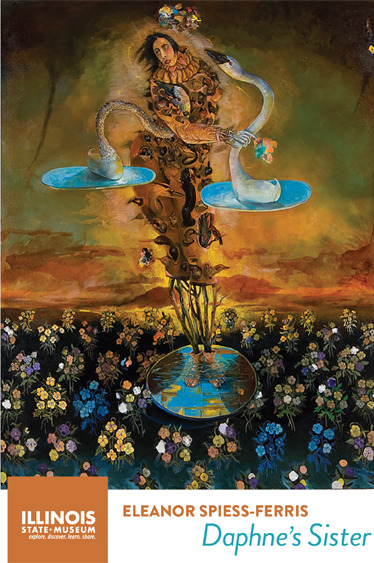
Eleanor Spiess-Ferris: Daphne’s Sister
Eleanor Spiess-Ferris (b. 1941, Las Vegas, NM. Resides, Chicago IL) is known for her distinctive approach to the figure, almost always women, who perform in dramatic settings. Her women are divas: larger than life, central to the story, and, like all good heroines, troubled by adversaries and circumstance.
Spiess-Ferris’s attention to the narrative body has deep art historical roots. Major influences are the visionary paintings of Hieronymus Bosch; Mannerist and Baroque arts attenuation of form and emotional atmosphere; Symbolist and Surrealist approaches to the fantastic, unreal situation and Feminist thought in the conflation of personal and political realities of women through history. Spiess-Ferris’s work is part of a strong tradition of figurative painting in the Midwest, which includes her contemporaries, Phyllis Bramson, Robert Lostutter, Tony Phillips, Christina Ramberg, and Suellen Rocca, along with modernist artists such as Gertrude Abercrombie, Ivan Albright, and Seymour Rosofsky.
In addition to her exploration of the figure, Spiess-Ferris also turns to the natural world for source material and inspiration. Her work is filled with birds, animals, flowers, trees, and water; constant companions and characters that help narrate the intertwined connection of humanity and nature. The questions of what animates and motivates us, as well as the consequence of our actions on the natural world, are central to her work.
This exhibition traces the development of Spiess-Ferris’s distinctive figures over 40 years of painting and drawing, often comparing studies and sketches with her final works. Spiess-Ferris has been drawing from a live model since the beginning of her career; an essential practice for her experimentation with the narrative figure. Her life studies often transform into their mythic selves in the process of a drawing session, shifting from observation into invention through distorting proportions and imposing natural forms as essential elements of the body.
Doug Stapleton, Associate Curator of Art, Illinois State Museum


(installation views: Eleanor Spiess-Ferris: Daphne’s Sister, Illinois State Museum, Springfield, IL, October 26, 2019 - February 16, 2020)
…[T]he shift we undergo from our world to her world, the immersion into some parallel universe when nature, animals, and humans all exist, just as we think we know them, but now functioning as integers in surprising and evocative narratives of mystery and wonder …’ —James Yood, Eleanor Spiess-Ferris: An Appreciation, Sorrow of Swans, 2009, exhibition catalog
The exhibition title Daphne’s Sister references the ancient Greek story of the nymph Daphne, who is transformed into a laurel tree to save her from the god Apollo’s unwanted advances. Spiess-Ferris never names Daphne in her work, but the suffering and endurance at the crux of Daphne’s story resonates through it. Spiess-Ferris’ figures are often depicted as hybrid creatures part human and part tree or bird, acknowledging shape-shifting as a strategy for survival. What is important in Daphne’s story is not that Apollo claims the laurel tree as his emblem, but that Daphne survives and thrives as a new species.
This painting, Fecundity, 2013, is a Daphne-like figure. She is a hardworking woman; balancing twin swan filled pools in a field of pansies while standing on delicate twig legs. She is between being and becoming, harboring life in her hands, but cautiously eyeing two approaching funnel clouds. If fecundity is a powerful productivity, then it is difficult, precarious work. The painting asks how we keep our balance, our sense of right and wrong, in relationship to all that we juggle.

Eleanor Spiess-Ferris, Fecundity, 2013, Oil on linen, Courtesy of the artist. ©Eleanor Spiess-Ferris

Eleanor Spiess-Ferris, Study for The Marauders, 1989, Graphite and colored pencil on sketchbook page, gift of the artist, 2018.41.59. ©Eleanor Spiess-Ferris

Figures are the essential storyteller in Eleanor Spiess-Ferris’s work. As such, the artist is more interested in how she can exaggerate her figures, bending, twisting and enlarging the forms to emphasize the emotional content of the work. Likewise, Spiess-Ferris is equally versed in rendering the figure with life-like realism. She has been involved for decades with the Evanston Figurative League, a group of artists who regularly draw from the figure as a means of honing their drawing and observational skills. Throughout the exhibition are examples of her drawings from the figure, which seem to stand in contrast to the exaggerated figures seen in the final paintings. Yet all of these images, from the quick contour sketch to the several hour-long poses from a model, speak to her understanding of how skin and bone, posture and gesture, can carry emotion and meaning. For her, imagination comes from observation, the original form elaborated and stretched into strange, new narrative figures.
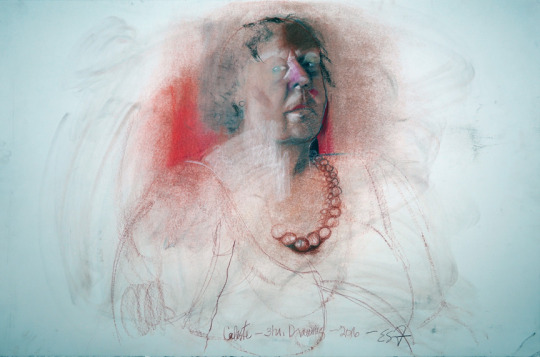
Eleanor Spiess Ferris, Untiled study (Celeste), 2016, Conte on paper, Courtesy of the artist. ©Eleanor Spiess-Ferris

Eleanor Spiess-Ferris, Lily, nd, Mixed media on paper, Courtesy of the artist. ©Eleanor Spiess-Ferris

Eleanor Spiess-Ferris, I Met a Rainbow in Argyle, 1976, Oil on canvas, Courtesy of the artist. ©Eleanor Spiess-Ferris
Spiess-Ferris’s paintings are allegories of the tides of fortune and consequence played out in often absurd situations. Her cast of characters includes clowns, ghosts, swan women, goddesses, suited skeletons, hobby horses, scarecrows, and crows. Spiess-Ferris’s figures are sometimes the main character, other times they are bystander or victim, pecked at by scavengers or poked and prodded by Picadillos—clownish demons. Who are her companions—these beasts and birds that accompany and sometimes inhabit the figure—and what is their part in the drama? They represent our interconnection, our intertwined fate with the natural world. They accompany the heroine on her many journeys; the birds are her voice; the demons are the embodiment of the consequence of our actions on a world turning uninhabitable.
These characters inhabit various worlds. In her early paintings from the 1980s and 1990s, you find them in stage-like settings with the curtains pulled back, revealing a tumbling operatic scene. In her later work, her figures move out into the world, floating in dark watery expanses or dwelling deep in the forest, more of residents now than actors passing through the scene.
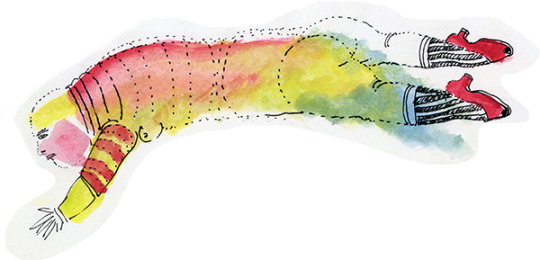
Spiess-Ferris’s earliest figures from the 1970s are rendered quickly, with a strong outline, minimal detail and broad strokes of color. These figures draw deeply on her childhood memories of northern New Mexico, especially the religious processions of the Spanish Penitentes and the ceremonies of the Pueblo Indians. In particular the sacred clown in Pueblo belief, a trickster who uses humor to make social commentary, has had a lasting impression on Spiess-Ferris’s figures. Northern Renaissance painter Hieronymus Bosch’s narratives scenes of Christian morality, heaven and hell as grotesque, carnival-like spectacle, also informs her work. These influences find bearing in her earliest paintings, such as the rainbow figure of I Met a Rainbow in Argyle and likewise in the drawing collage, Heaven, No Exit.
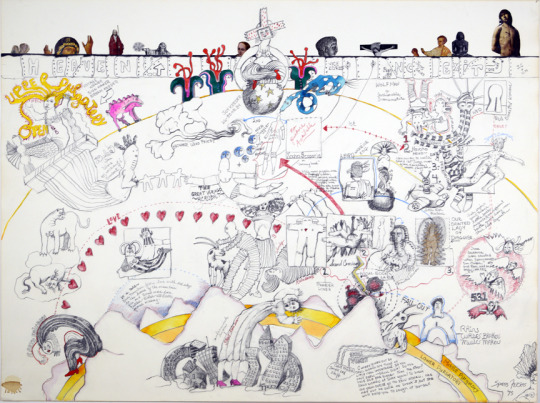
Eleanor Spiess-Ferris, Heaven No Exit, 1975, Graphite, color pencil, marker and collage on paper, Courtesy of the artist. ©Eleanor Spiess-Ferris

Eleanor Spiess-Ferris The Gray Room, 1980, Oil on canvas, Gift of the artist, 2009.26. ©Eleanor Spiess-Ferris
Spiess-Ferris's figures are rarely whole creatures. They are often depicted as fragments of a body or as hollowed skin or shell. The question of what animates us is central to her work. Is our outward appearance—how we present ourselves to the world—the true reflection of our inner life or just a costume we wear?
In Gray Room, 1980, Spiess-Ferris critiques the difficulty for women in finding their bearing and balance in a world where they are seen as sexual fantasies. The true person is not seen, only her ghost of a form, dressed up outlandishly. As a young artist finding her artistic voice, she used this ghost form repeatedly in her early work as an appraisal of female identity.
The idea of clothes animated to appear like human forms stem from Spiess-Ferris’s childhood memory of seeing clothes blown off a clothesline and caught up in tree branches. The clothes appeared to be alive as they billowed in the wind, as if the trees were dressing up to be recognized as human.

Eleanor Spiess-Ferris, Wild Sticks, 1982, Oil on Linen, Courtesy of the artist. ©Eleanor Spiess-Ferris
The memory of family from her New Mexican childhood inspire Spiess-Ferris’s Wild Stick figures, which are part of a series recollecting the daring exploits of her Aunt Maggie on horseback as well as her own memories of riding her palomino horse Snake. The memories—faded with the years and informed by pressing issues of adulthood—become ghost women riding hobby horses in a raucous race. Hobby horses symbolize a repeated activity—something we return to again and again—and these figures seem to be endlessly, urgently racing through time and space.
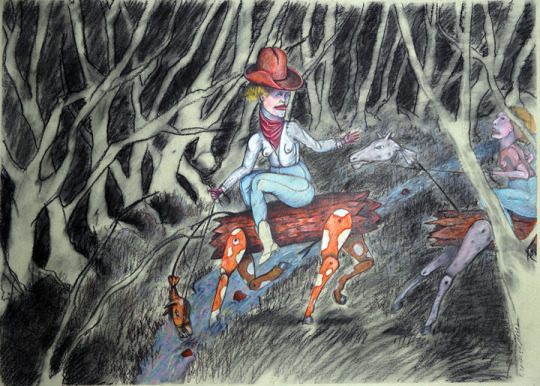
©Eleanor Spiess-Ferris
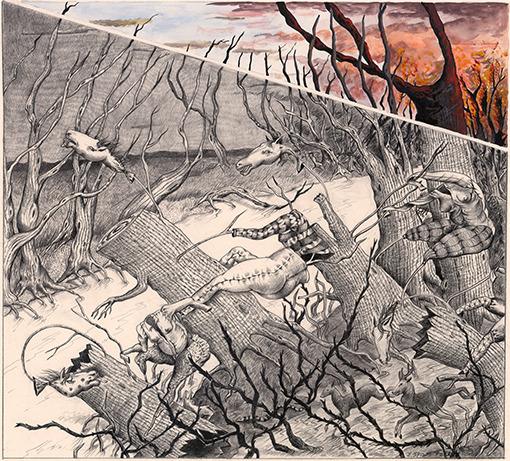
Eleanor Spiess-Ferris, Study for Wild Hunt, c. 1980s, graphite and gouache on paper, Gift of the artist. ©Eleanor Spiess-Ferris

Eleanor Spiess-Ferris, River, 2012, Oil on canvas, Courtesy of the artist. ©Eleanor Spiess-Ferris
Birds are a constant companion and inhabitant in Spiess-Ferris’s work; their chorus is its voice and breath. Birds inhabit the figure, nesting and finding protection in the limbs or the folds of the body. In River, 2012, they are an exposed nerve, a life force on a string held suspended above flowing time. James Yood wrote, ‘Birds are almost everywhere in her work as well, preening, pricking, nesting, cavorting, instinctive foils for the humans they abut, in their lust and vanity and hunger to survive becoming just like us.*’
* James Yood, Eleanor Spiess-Ferris: An Appreciation, Sorrow of Swans, 2009

Eleanor Spiess-Ferris, Tears, 2007, Oil on Canvas, Courtesy of the artist. ©Eleanor Spiess-Ferris
Eleanor Spiess-Ferris’s paintings balance absurdity and compassion. At first glance, we recognize their theatricality: outlandish costumes and hairstyles coupled with contortionist poses and dramatic lighting, which give the appearance of high comedy and satire. But the central storytelling brings us back to our own humanness and to the natural world, especially our relationship with water. There is a strong liaison with water—tears, sorrow, and regeneration—in Spiess-Ferris’s work, but rarely is this element single-purposed. In Tears, 2007, weeping women cry into vials that than pour out on the land, flooding the landscape. One woman offers small candle boats as an act of remembrance, while another carries her ancestors floating in her bowl-shaped head. In an interview, Spiess-Ferris explains,” Grief is not just totally bad—something comes out of it. … [S]he creates …by crying …she creates the environment in which the birds and things can exist through her grief. She’s an ecosystem. And she cries and will forever cry, but with her tears comes life.” *
*Gavin Van Horn, 2013, June 7, The Artist Who Would Be Crow, Center for Humans and Nature, www.humansandnature.org
Spiess-Ferris’s figures, armored and constricted in cloth as tight as skin, bristle in quilted or scaled discomfort. Bodies twist and double over or distort to resemble strange bug carapaces, as in A Small Sound, 2016. Deliberately distorted, these figures act as a visceral reminder of how we feel emotions in our bodies. There is something powerful in the contorted figures, which, like clowns and jesters, use absurdity to drive home a pinprick of recognition of ourselves.

A Small Sound, 2016, Gouache on paper, Courtesy of Audrey Niffenegger. ©Eleanor Spiess-Ferris

Eleanor Spiess-Ferris, The Chair, 2010, Gouache on paper, Courtesy of the artist. ©Eleanor Spiess-Ferris

Eleanor Spiess-Ferris A Mama’s Tears (study for The Chair, 2011), n.d. (c.2011), graphite on paper, Gift of the artist. ©Eleanor Spiess-Ferris

Eleanor Spiess-Ferris, Islands, 2004, Oil on Linen, Courtesy of the artist. ©Eleanor Spiess-Ferris
In Islands, 2002, garland-wreathed heads float as a silent procession in a sunken, twilight world, each person calmly surveying the darkness by the light of a powerful spirit lamp. Are these heads the islands of this title, or is the island our collective humanity afloat in a larger world full of unknowns? Some figures sport elaborate collars or wreaths of flowers around their neck, while another wears a wooden dunce hat full of birds. In the middle, one man balances a single white lily stalk, symbolizing the Virgin Mary—the compositional centerpiece of this procession of hope and mercy. ‘The theme of caretaking strongly transmits,’ writes nature and ethics scholar Gavin Van Horn. ‘There is a guarded optimism in the organic intertwining of human and nonhuman life, in which heads become lifeboats, thoughts become branches filled with song and chatter, and bodies are pierced and re-aggregated into something greater than their parts.*’
*Gavin Van Horn, 2013, June 7, The Artist Who Would Be Crow, Center for Humans and Nature, www.humansandnature.org

Eleanor Spiess-Ferris, Inflated Ego, 2008, Oil on Canvas, Courtesy of the artist. ©Eleanor Spiess-Ferris
I wish there were better words to describe the emotional tenor of a work by Spiess-Ferris, melancholic, brooding, wistful, heartfelt, poignant, tragic, tender, etc., none fully does the trick, but in some combination, help to gauge the psychological temperature that she regularly achieves. The complex Inflated, Egos, 2008, is so diverse and rich, it takes us to a place of dreams and nightmares, fireballs cascading from the orange and apocalyptic sky while, in a sliver of blue water, a few of Spiess-Ferris’s signature actors and actresses float about on or among some very expressive swans. There’s a hothouse and claustrophobic feeling here, we see broad areas of suggestive emptiness juxtaposed with an intense but ambiguous narrative episode. Why are these curiously costumed individuals sailing about, … sporting inefficient and symbolic umbrellas and the like… what is their relationship to one another, are they vulnerable or somehow self-contained? More questions than answers, as is often true in this artist’s work—but images such as this provide that aperture to wonder and imagination that invite us to speculate and fantasize, to question and, finally, to surrender.
James Yood, Eleanor Spiess-Ferris: An Appreciation, Sorrow of Swans, 2009
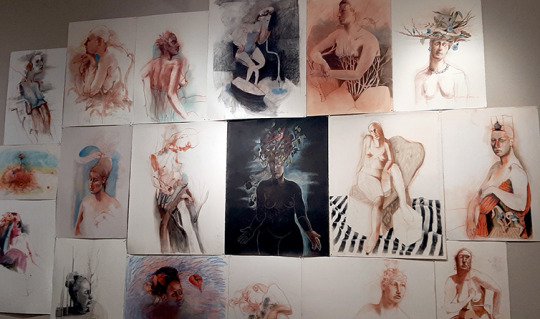

(installation views: Eleanor Spiess-Ferris: Daphne’s Sister, Illinois State Museum, Springfield, IL, October 26, 2019 - February 16, 2020)
Additional images

Eleanor Spiess-Ferris, Autumn, 2002, Oil on linen, Courtesy of the artist. ©Eleanor Spiess-Ferris

Eleanor Spiess-Ferris, Untitled Figure study, Nd., Conte on paper, Courtesy of the artist. ©Eleanor Spiess-Ferris

Eleanor Spiess-Ferris, Gathering Swans, 2002, Oil on canvas, Courtesy of the artist. ©Eleanor Spiess-Ferris
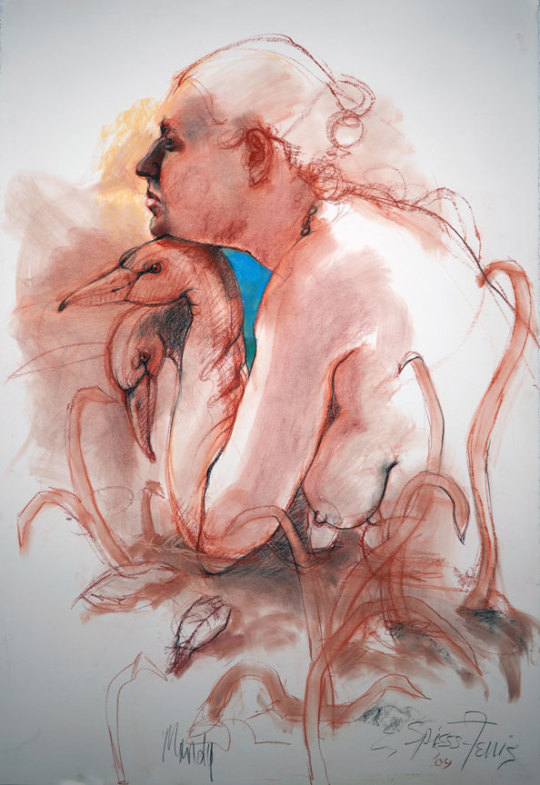
Eleanor Spiess-Ferris, Untitled study (Mandy), 2004, Conte on paper, Courtesy of the artist. ©Eleanor Spiess-Ferris

©Eleanor Spiess-Ferris
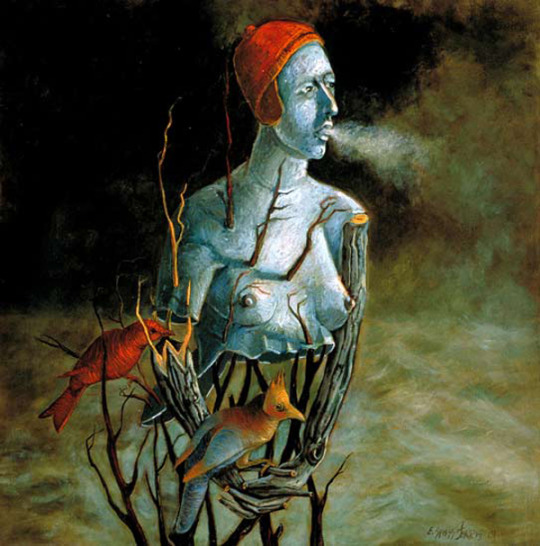
Eleanor Spiess-Ferris, Those That Were Left Behind, 2002, Oil on canvas, Courtesy of the artist. ©Eleanor Spiess-Ferris

Eleanor Spiess-Ferris, Untitled study (related to Those That Were Left Behind, 2002), Nd, Conte on paper, Courtesy of the artist. ©Eleanor Spiess-Ferris
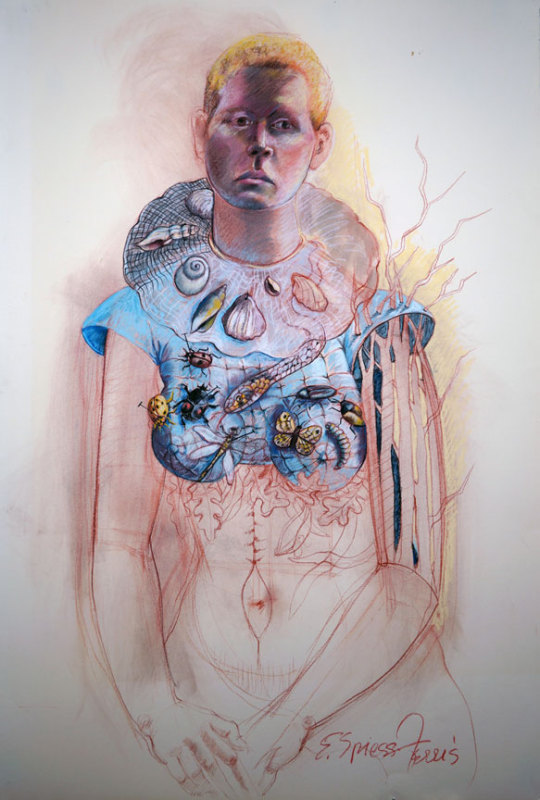
Eleanor Spiess-Ferris, Untitled (related to figure in The Basket, 1993), 1990s, Conte on paper, 30 ¼ x 44”, Courtesy of the artist. ©Eleanor Spiess-Ferris

©Eleanor Spiess-Ferris
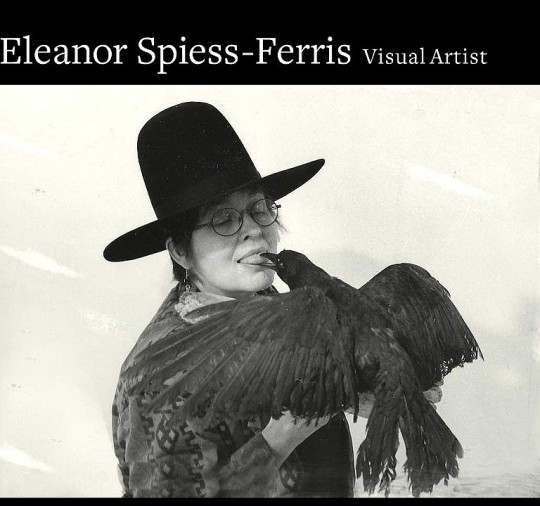
Eleanor Spiess-Ferris: Daphne’s Sister was presented at the Illinois State Museum, Springfield, IL, October 2019 - Feburary 2020, and at the Evanston Art Center, Evanston, IL, March 2020.
0 notes